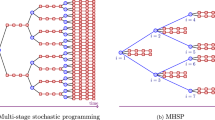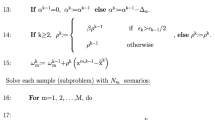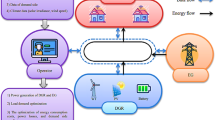Abstract
In energy management, the unit-commitment problem deals with computing the most cost-efficient production schedule that meets customer load, while satisfying the operational constraints of the units. When the problem is large scale and/or much modelling detail is required, decomposition approaches are vital for solving this problem. The recent strong increase in intermittent, relative unforeseeable production has brought forth the need of examining methods from stochastic programming. In this paper we investigate and compare four such methods: probabilistically constrained programming, robust optimization and 2-stage stochastic and robust programming, on several large-scale instances from practice. The results show that the robust optimization approach is computationally the least costly but difficult to parameterize and has the highest recourse cost. The probabilistically constrained approach is second as computational cost is concerned and improves significantly the recourse cost functions with respect to the robust optimization approach. The 2-stage optimization approaches do poorly in terms of robustness, because the recourse decisions can compensate for this. Their total computational cost is highest. This leads to the insight that 2-stage flexibility and robustness can be (practically) orthogonal concepts.



Similar content being viewed by others
References
Beltran C, Heredia FJ (2002) Unit commitment by augmented lagrangian relaxation: testing two decomposition approaches. J Optim Theory Appl 112(2):295–314
Ben-Salem S (2011) Gestion Robuste de la production électrique à horizon court-terme. PhD thesis, Ecole Centrale Paris, Mars
Ben-Tal A, El Ghaoui L, Nemirovski A (2009) Robust optimization. Princeton University Press, Princeton
Bertsimas D, Litvinov E, Sun XA, Zhao J, Zheng T (2013) Adaptive robust optimization for the security constrained unit commitment problem. IEEE Trans Power Syst 28(1):52–63
Birge JR, Louveaux F (1988) A multicut algorithm for two-stage stochastic linear programs. Eur J Oper Res 34(3):384–392
Birge JR, Louveaux F (1997) Introduction to stochastic programming. Springer, New York
Bonnans JF, Gilbert JC, Lemaréchal C, Sagastizábal C (2006) Numerical optimization: theoretical and practical aspects, 2nd edn. Springer, Berlin
Borghetti A, Frangioni A, Lacalandra F, Nucci CA (2003) Lagrangian heuristics based on disaggregated bundle methods for hydrothermal unit commitment. IEEE Trans Power Syst 18:313–323
Bremer I, Henrion R, Möller A (2015) Probabilistic constraints via SQP solver: application to a renewable energy management problem. Comput Manag Sci 12:435–459
Bruhns A, Deurveilher G, Roy JS (2005) A non-linear regression model for mid-term load forecasting and improvements in seasonality. PSCC 2005 Luik
Carrión M, Arroyo JM (2006) A computationally efficient mixed-integer linear formulation for the thermal unit commitment problem. IEEE Trans Power Syst 21(3):1371–1378
Daniildis A, Lemaréchal C (2005) On a primal-proximal heuristic in discrete optimization. Math Program Ser A 104:105–128
de Oliveira W, Sagastizábal C (2014) Level bundle methods for oracles with on demand accuracy. Optim Methods Softw 29(6):1180–1209
de Oliveira W, Sagastizábal C, Lemaréchal C (2014) Convex proximal bundle methods in depth: a unified analysis for inexact oracles. Math Program Ser B 148:241–277
Dentcheva D (2009) Optimisation models with probabilistic constraints. In: Shapiro A, Dentcheva D, Ruszczynski A (eds) Lectures on stochastic programming. Modeling and theory, MPS-SIAM series on optimization, vol 9. SIAM and MPS, Philadelphia
Ding X, Lee W-J, Jianxue W, Liu L (2010) Studies on stochastic unit commitment formulation with flexible generating units. Electr Power Syst Res 80:130–141
Dubost L, Gonzalez R, Lemaréchal C (2005) A primal-proximal heuristic applied to french unitcommitment problem. Math Program 104(1):129–151
Dyer ME, Frieze AM (1988) On the complexity of computing the volume of a polyhedron. SIAM J Comput 17(5):967–974
Feltenmark S, Kiwiel KC (2000) Dual applications of proximal bundle methods, including lagrangian relaxation of nonconvex problems. SIAM J Optim 10(3):697–721
Finardi EC, Da Silva EL (2006) Solving the hydro unit commitment problem via dual decomposition and sequential quadratic programming. IEEE Trans Power Syst 21(2):835–844
Frangioni A, Gentile C, Lacalandra F (2008) Solving unit commitment problems with general ramp contraints. Int J Electr Power Energy Syst 30:316–326
Frangioni A, Gentile C, Lacalandra F (2011) Sequential Lagrangian-MILP approaches for unit commitment problems. Int J Electr Power Energy Syst 33:585–593
Genz A (1992) Numerical computation of multivariate normal probabilities. J Comput Graph Stat 1:141–149
Genz A, Bretz F (2009) Computation of multivariate normal and t probabilities. In: Number 195 in Lecture Notes in Statistics. Springer, Dordrecht
Gersho A, Gray RM (1992) Vector Quantization and Signal Compression. In: Number 159 in The Springer International Series in Engineering and Computer Science. Springer, US
Henrion R, Möller A (2012) A gradient formula for linear chance constraints under Gaussian distribution. Math Oper Res 37:475–488
Hiriart-Urruty JB, Lemaréchal C (1996) Convex Analysis and Minimization Algorithms I. In: Number 305 in Grundlehren der mathematischen Wissenschaften, 2nd edn. Springer
Hong LJ, Yang Y, Zhang L (2011) Sequential convex approximations to joint chance constrained programed: a monte carlo approach. Oper Res 3(59):617–630
Kall P, Mayer J (2005) Stochastic linear programming: models, theory and computation. International series in operations research and management science, 1st edn. Springer, New York
Lejeune MA (2012) Pattern-based modeling and solution of probabilistically constrained optimization problems. Oper Res 60(6):1356–1372
Lloyd S (1982) Least squares quantization in pcm. IEEE Trans Inf Theory 28(2):129–137
Luedtke J (2010) An integer programming and decomposition approach to general chance-constrained mathematical programs. In: Eisenbrand F, Shepherd FB (eds) Integer programming and combinatorial optimization, lecture notes in computer science, vol 6080. Springer, Berlin, pp 271–284
Luedtke J (2014) A branch-and-cut decomposition algorithm for solving chance-constrained mathematical programs with finite support. Math Program 146(1–2):219–244
Minoux M (2014) Two-stage robust optimization, state-space representable uncertainty and applications. RAIRO-Oper Res 48:455–475
Morales-España G, Latorre JM, Ramos A (2013) Tight and compact MILP formulation for the thermal unit commitment problem. IEEE Trans Power Syst 28(4):4897–4908
Morales-España G, Latorre JM, Ramos A (2013) Tight and compact MILP formulation of start-up and shut-down ramping in unit commitment. IEEE Trans Power Syst 28(2):1288–1296
Nemirovski A, Shapiro A (2006) Convex approximations of chance constrained programs. SIAM J Optim 17(4):969–996
Ozturk UA, Mazumdar M, Norman BA (2004) A solution to the stochastic unit commitment problem using chance constrained programming. IEEE Trans Power Syst 19(3):1589–1598
Pagès G, Printems J (2003) Optimal quadratic quantization for numerics: the gaussian case. Monte Carlo Methods Appl 9(2):135–166
Prékopa A (1995) Stochastic programming. Kluwer, Dordrecht
Prékopa A (2003) Probabilistic programming. In: Ruszczyński A, Shapiro A (eds) Stochastic programming. Handbooks in operations research and management science, vol 10. Elsevier, Amsterdam
Ruszczyński A (2003) Decomposition methods. In: Ruszczyński A, Shapiro A (eds) Stochastic programming. Handbooks in operations research and management science, vol 10. Elsevier, Amsterdam
Sagastizábal C (2012) Divide to conquer: decomposition methods for energy optimization. Math Program 134(1):187–222
Shan F, Zhang LW, Xiao X (2014) A smoothing function approach to joint chance constrained programs. J Optim Theory Appl 163:181–199
Tahanan M, van Ackooij W, Frangioni A, Lacalandra F (2015) Large-scale unit commitment under uncertainty: a literature survey. 4OR 13(2):115–171
Takriti S, Birge JR (2000) Using integer programming to refine lagrangian-based unit commitment solutions. IEEE Trans Power Syst 15(1):151–156
van Ackooij W (2014) Decomposition approaches for block-structured chance-constrained programs with application to hydro-thermal unit commitment. Math Methods Oper Res 80(3):227–253
van Ackooij W, de Oliveira W (2014) Level bundle methods for constrained convex optimization with various oracles. Comput Optim Appl 57(3):555–597
van Ackooij W, Henrion R, Möller A, Zorgati R (2010) On probabilistic constraints induced by rectangular sets and multivariate normal distributions. Math Methods Oper Res 71(3):535–549
van Ackooij W, Henrion R, Möller A, Zorgati R (2014) Joint chance constrained programming for hydro reservoir management. Optim Eng 15:509–531
van Ackooij W, Malick J (2014) Decomposition algorithm for large-scale two-stage unit-commitment. Draft submitted, http://www.optimization-online.org/DB_HTML/2015/04/4873.html, pages 1–26, 2014
van Ackooij W, Minoux M (2015) A characterization of the subdifferential of singular Gaussian distribution functions. Set valued and variational analysis. pages 1–19 (to appear in)
van Ackooij W, Sagastizábal C (2014) Constrained bundle methods for upper inexact oracles with application to joint chance constrained energy problems. SIAM J Optim 24(2):733–765
Wang SJ, Shahidehpour M, Kirschen DS, Mokhtari S, Irisarri GD (1995) Short-term generation scheduling with transmission and environmental constraints using an augmented lagrangian relaxation. IEEE Trans Power Syst 10(3):1294–1301
Xiong P, Jirutitijaroen P (2011) Stochastic unit commitment using multi-cut decomposition algorithm with partial aggregation. In IEEE Power and Energy Society General Meeting
Zaourar S, Malick J (2013) Prices stabilization for inexact unit-commitment problems. Math Methods Oper Res 78(3):341–359
Zhuang F, Galiana FD (1988) Towards a more rigorous and practical unit commitment by lagrangian relaxation. IEEE Trans Power Syst 3(2):763–773
Zugno M, Conejo AJ (2013) A robust optimization approach to energy and reserve dispatch in electricity markets. Technical report, University of Denmark
Acknowledgments
The author would like to thank three anonymous referees for their comments that helped improve this paper.
Author information
Authors and Affiliations
Corresponding author
Appendix: Didactic toy example
Appendix: Didactic toy example
In this appendix we present a small example that may help the reader visualize the difference and similarities between the suggested models.
The set of assets consists of two thermal plants, subject to power limits and ramping rates. There are only two stages and time steps in the problem and only the load in the second time step, i.e. second stage, is uncertain (see Table 12 for further data).
The deterministic load is equal to \(d = (0.75,0.75)\), and the second-stage load varies uniformly in the interval (0.25, 1.25). The bounds in (1) are \(s^d = (0.0, -0.1)\), \(s^u=(0.0,0.5)\). In what follows \(p^1 = (p^1_1, p^1_2)\) will denote the production level of the first unit and \(p^2 = (p^2_1, p^2_2)\) that of the second.
1.1 The deterministic approach
One can readily observe that the optimal solution is to use unit 1 only and produce (0.75, 0.5) for a total cost of 13.75. Note that the minimal stable generation of 0.5 prevents this unit from decreasing its production in the second stage further. Unit 2 remains offline.
1.2 The 2-stage approach
The situation is now rather different and partially depends on the possibility for us to switch off unit 1 in the second time step, when \(d_2\) has been observed. If this can be done, unit 1 can still be online in the first time step. Then a feasible strategy is one wherein unit 1 produces 0.75 in the first time step and
-
1.
if \(d_2 < 0.4\), shutdown unit 1 and use unit 2 to generate 0.25 MW.
-
2.
if \(d_2 \in [0.4,1.0]\), unit 1 produces at MSG in the second time step
-
3.
if \(d_2 \in (1.0,1.25]\), unit 1 produces \(d_2 - 0.5\) in the second time step.
One can readily compute that this solution leads to an expected cost of 15.3063. A second feasible solution is to only use unit 2. In this situation unit 2 produces 0.75 in the first time step and
-
1.
if \(d_2 < 0.75\), unit 2 generates 0.25 MW in the second time step.
-
2.
if \(d_2 \in [0.75,1.25]\), unit 2 produces \(d_2 - 0.5\) in the second time step.
The expected cost is 15.6250, making this a suboptimal solution.
If unit 1 has to remain online in the second stage, the first strategy described above leads to an infeasible second-stage problem for several random realizations. Consequently only the second strategy remains feasible and hence optimal.
1.3 The probabilistically constrained approach
In this situation the probability constraint (3) becomes \(\mathbb {P}[d_2 - 0.5 \le p^1_2 + p^2_2 \le d_2 + 0.1] \ge p\). For a given probability level of say \(p=0.55\), we can observe that the probability request can be alternatively cast as the following linear constraint \(0.3 \le p^1_2 + p^2_2 \le 0.8\). In this particular situation, the probabilistically constrained model is more demanding than the deterministic model, which requests \(0.25 \le p^1_2 + p^2_2 \le 0.85\), but the difference is not seen on the optimal solution due to the MSG restriction on the first unit. The optimal solution is therefore to use unit 1 to generate \(p^1=(0.75,0.5)\) and keep unit 2 offline.
1.4 The robust constrained approach
An uncertainty set \(\mathcal {D}\) consistent with the above probabilistically constrained model would be \(\mathcal {D} = \left\{ d \in R^2 \; : d_1 = 0.75, d_2 \in [\bar{d},\bar{d} + 0.55]\right\} \). With such an uncertainty set, the constraint (5) related to the second time step reads \(\bar{d} + 0.05 \le p^1_2 + p^2_2 \le \bar{d} + 0.1\).
This leads to the following set of solutions:
-
1.
For \(\bar{d} \in [0.25,0.4)\), use unit 2 to produce 0.75 in the first time step and \(\bar{d} + 0.05\) in the second time step. The cost of this solution lies in the interval [15.25, 16).
-
2.
For \(\bar{d} \in [0.4,0.45]\), use unit 1 to produce 0.75 in the first time step and 0.5 in the second time step. The cost of this solution is 13.75.
-
3.
For \(\bar{d} \in (0.45,0.7]\), use unit 1 to produce 0.75 in the first time step and \(\bar{d} + 0.05\) in the second time step. The total cost lies in the interval [13.75, 14.50].
1.5 The 2-stage robust approach
Here the situation depends only on the given uncertainty set \(\mathcal {D}\) and not on the flexibility of unit 1 as in the stochastic 2-stage approach.
Indeed, assuming that the first unit can be switched off in the second stage, then as soon as there exists \(d \in \mathcal {D}\) with \(d_2 < 0.4\), the worst-case cost of strategy 1 exhibited in the 2-stage stochastic approach is highly costly as it involves two starting costs (it is 23.5). Consequently only the second solution involving only unit 2 is retained. If unit 1 cannot be switched off, the solution strategy involving unit 1 is not even feasible.
However, as long as any \(d \in \mathcal {D}\) has \(d_2 \ge 0.4\) the first strategy is optimal, independently of whether or not unit 1 can be switched off or not.
1.6 A remark on comparing 2-stage and mono-stage approaches
Following the framework laid out in (8) both 2-stage approaches compute an optimal strategy that depends on various problem characteristics, but also a first-stage vision of the future (called x in (7)). For, the strategy involving unit 1 this vision would be \(p^1 = (0.75,0.5)\), \(p^2=(0,0)\). The strategy involving unit 2 would provide a first-stage vision \(p^1=(0,0)\), \(p^2=(0.75,0.25)\). Note that this first-stage vision can be compared with the solutions obtained from the mono-stage approaches and vice versa.
Rights and permissions
About this article
Cite this article
van Ackooij, W. A comparison of four approaches from stochastic programming for large-scale unit-commitment. EURO J Comput Optim 5, 119–147 (2017). https://doi.org/10.1007/s13675-015-0051-x
Received:
Accepted:
Published:
Issue Date:
DOI: https://doi.org/10.1007/s13675-015-0051-x




